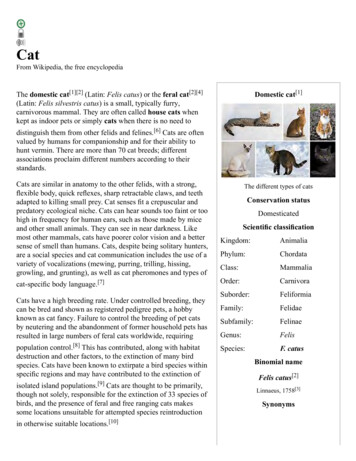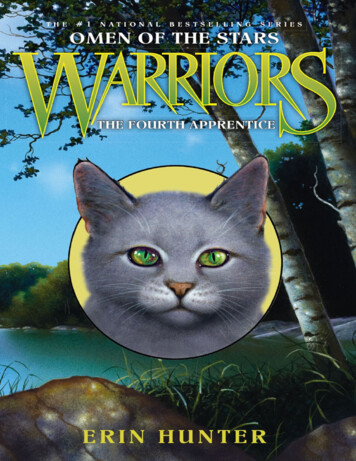
Transcription
CatFrom Wikipedia, the free encyclopediaThe domestic cat[1][2] (Latin: Felis catus) or the feral cat[2][4](Latin: Felis silvestris catus) is a small, typically furry,carnivorous mammal. They are often called house cats whenkept as indoor pets or simply cats when there is no need toDomestic cat[1]distinguish them from other felids and felines.[6] Cats are oftenvalued by humans for companionship and for their ability tohunt vermin. There are more than 70 cat breeds; differentassociations proclaim different numbers according to theirstandards.Cats are similar in anatomy to the other felids, with a strong,flexible body, quick reflexes, sharp retractable claws, and teethadapted to killing small prey. Cat senses fit a crepuscular andpredatory ecological niche. Cats can hear sounds too faint or toohigh in frequency for human ears, such as those made by miceand other small animals. They can see in near darkness. Likemost other mammals, cats have poorer color vision and a bettersense of smell than humans. Cats, despite being solitary hunters,are a social species and cat communication includes the use of avariety of vocalizations (mewing, purring, trilling, hissing,growling, and grunting), as well as cat pheromones and types ofcat-specific body language.[7]Cats have a high breeding rate. Under controlled breeding, theycan be bred and shown as registered pedigree pets, a hobbyknown as cat fancy. Failure to control the breeding of pet catsby neutering and the abandonment of former household pets hasresulted in large numbers of feral cats worldwide, requiringpopulation control.[8] This has contributed, along with habitatdestruction and other factors, to the extinction of many birdspecies. Cats have been known to extirpate a bird species withinspecific regions and may have contributed to the extinction ofpopulations.[9]isolated islandCats are thought to be primarily,though not solely, responsible for the extinction of 33 species ofbirds, and the presence of feral and free ranging cats makessome locations unsuitable for attempted species reintroductionin otherwise suitable locations.[10]The different types of catsConservation statusDomesticatedScientific :FelidaeSubfamily:FelinaeGenus:FelisSpecies:F. catusBinomial nameFelis catus[2]Linnaeus, 1758[3]Synonyms
Since cats were venerated in ancient Egypt, they wereFelis silvestris catus (subjectivecommonly believed to have been domesticated there,[11] butthere may have been instances of domestication as early as thesynonym)[4]Neolithic from around 9,500 years ago (7,500 BCE).[12] Agenetic study in 2007 concluded that domestic cats aredescended from Near Eastern wildcats, having diverged aroundsynonym)[5]Felis catus domestica (invalid junior8,000 BCE in West Asia.[11][13] A 2016 study found that leopard cats were undergoing domesticationindependently in China around 5,500 BCE, though this line of partially domesticated cats leaves no trace inthe domesticated populations of today.[14][15]As of a 2007 study, cats are the second most popular pet in the United States by number of pets owned,behind the first, which is freshwater fish.[16]Contents1 Taxonomy and evolution2 Nomenclature and etymology3 Biology3.1 Anatomy3.2 Physiology3.3 Senses3.4 Health3.4.1 Diseases3.4.2 Poisoning3.5 Genetics4 Behavior4.1 Sociability4.2 Communication4.3 Grooming4.4 Fighting4.5 Hunting and feeding4.6 Play4.7 Reproduction5 Ecology5.1 Habitats5.2 Feral cats5.3 Impact on prey species5.4 Impact on birds6 Interaction with humans6.1 History and mythology7 Depictions of cats in art8 See also9 References10 External links
Taxonomy and evolutionThe felids are a rapidly evolving family of mammals that share acommon ancestor only 10–15 million years ago[17] and include lions,tigers, cougars and many others. Within this family, domestic cats(Felis catus) are part of the genus Felis, which is a group of smallcats containing about seven species (depending upon classificationscheme).[1][18] Members of the genus are found worldwide andinclude the jungle cat (Felis chaus) of southeast Asia, Europeanwildcat (F. silvestris silvestris), African wildcat (F. s. lybica), theChinese mountain cat (F. bieti), and the Arabian sand cat (F.margarita), among others.[19]The domestic cat was first classified as Felis catus by Carl LinnaeusThe African wildcat, Felis silvestrislybica, is the ancestor of the domesticcat.in the 10th edition of his Systema Naturae published in 1758.[1][3]Because of modern phylogenetics, domestic cats are usuallyregarded as another subspecies of the wildcat, F. silvestris.[1][4][20]This has resulted in mixed usage of the terms, as the domestic catcan be called by its subspecies name, Felis silvestris catus.[1][4][20]Wildcats have also been referred to as various subspecies of F.catus,[20] but in 2003, the International Commission on ZoologicalNomenclature fixed the name for wildcats as F. silvestris.[21] Themost common name in use for the domestic cat remains F. catus,following a convention for domesticated animals of using the earliest(the senior) synonym proposed.[21] Sometimes, the domestic cat hasbeen called Felis domesticus[22] or Felis domestica,[1] as proposedby German naturalist J. C. P. Erxleben in 1777 but these are not validtaxonomic names and have been used only rarely in scientificAn Indian Domestic Cat atThiruvananthapuram,Keralaliterature,[23] because Linnaeus's binomial takes precedence.[24] Apopulation of Transcaucasian black feral cats was once classified as Felis daemon (Satunin 1904) but now thispopulation is considered to be a part of domestic cat.[25]All the cats in this genus share a common ancestor that probably lived around 6–7 million years ago inAsia.[26] The exact relationships within the Felidae are close but still uncertain,[27][28] e.g. the Chinesemountain cat is sometimes classified (under the name Felis silvestris bieti) as a subspecies of the wildcat,like the North African variety F. s. lybica.[4][27]In comparison to dogs, cats have not undergone major changes during the domestication process, as theform and behavior of the domestic cat is not radically different from those of wildcats and domestic cats areperfectly capable of surviving in the wild.[29][30] Fully domesticated house cats often interbreed with feral F.catus populations.[31] This limited evolution during domestication means that hybridisation can occur withmany other felids, notably the Asian leopard cat.[32] Several natural behaviors and characteristics of wildcats
may have preadapted them for domestication as pets.[30] These traits include their small size, social nature,obvious body language, love of play and relatively high intelligence.[33]:12–17 Several small felid speciesmay have an inborn tendency towards tameness.[30]Cats have either a mutualistic or commensal relationship with humans. Two main theories are given abouthow cats were domesticated. In one, people deliberately tamed cats in a process of artificial selection, asthey were useful predators of vermin.[34] This has been criticized as implausible, because the reward forsuch an effort may have been too little; cats generally do not carry out commands and although they do eatrodents, other species such as ferrets or terriers may be better at controlling these pests.[4] The alternativeidea is that cats were simply tolerated by people and gradually diverged from their wild relatives throughnatural selection, as they adapted to hunting the vermin found around humans in towns and villages.[4]Nomenclature and etymologyThe English word 'cat' (Old English catt) is in origin a loanword, introduced to many languages of Europefrom Latin cattus[35] and Byzantine Greek κάττα, including Portuguese and Spanish gato, French chat,German Katze, Lithuanian katė, and Old Church Slavonic kotka, among others.[36] The ultimate source ofthe word is Afroasiatic, presumably from Late Egyptian čaute,[37] the feminine of čaus "wildcat". Analternative word with cognates in many languages is English 'puss' ('pussycat'). Attested only from the 16thcentury, it may have been introduced from Dutch poes or from Low German puuskatte, related to Swedishkattepus, or Norwegian pus, pusekatt. Similar forms exist in Lithuanian puižė and Irish puiscín. Theetymology of this word is unknown, but it may have simply arisen from a sound used to attract a cat.[38][39]A group of cats is referred to as a "clowder" or a "glaring",[40] a male cat is called a "tom" or "tomcat"[41](or a "gib",[42] if neutered), an unaltered female is called a "queen",[43] and a juvenile cat is referred to as a"kitten". The male progenitor of a cat, especially a pedigreed cat, is its "sire",[44] and its female progenitor isits "dam".[45] In Early Modern English, the word 'kitten' was interchangeable with the now-obsolete word'catling'.[46]A pedigreed cat is one whose ancestry is recorded by a cat fancier organization. A purebred cat is one whoseancestry contains only individuals of the same breed. Many pedigreed and especially purebred cats areexhibited as show cats. Cats of unrecorded, mixed ancestry are referred to as domestic short-haired ordomestic long-haired cats, by coat type, or commonly as random-bred, moggies (chiefly British), or (usingterms borrowed from dog breeding) mongrels or mutt-cats.While the African wildcat is the ancestral subspecies from which domestic cats are descended, and wildcatsand domestic cats can completely interbreed (Being subspecies of the same species), several intermediatestages occur between domestic pet and pedigree cats on one hand and those entirely wild animals on theother. The semiferal cat, a mostly outdoor cat, is not owned by any one individual, but is generally friendlyto people and may be fed by several households. Feral cats are associated with human habitation areas andmay be fed by people or forage for food, but are typically wary of human interaction.[31]Biology
AnatomyDomestic cats are similar in size to the othermembers of the genus Felis, typically weighingbetween 4 and 5 kg (9 and 10 lb).[27] Somebreeds, however, such as the Maine Coon, canoccasionally exceed 11 kg (24 lb). Conversely,very small cats, less than 2 kg (4 lb), have beenreported.[47] The world record for the largest catis 21 kg (50 lb).[48] The smallest adult cat everofficially recorded weighed around 1 kgDiagram of the general anatomy of a male(2 lb).[48] Feral cats tend to be lighter as theyhave more limited access to food than house cats. In the Boston area, the average feral adult male will weigh4 kg (9 lb) and average feral female 3 kg (7 lb).[49] Cats average about 23–25 cm (9–10 in) in height and46 cm (18 in) in head/body length (males being larger than females), with tails averaging 30 cm (12 in) inlength.[50]Cats have seven cervical vertebrae, as do almost all mammals; 13 thoracic vertebrae (humans have 12);seven lumbar vertebrae (humans have five); three sacral vertebrae like most mammals (humans have five);and a variable number of caudal vertebrae in the tail (humans retain three to five caudal vertebrae, fused intoan internal coccyx).[51]:11 The extra lumbar and thoracic vertebrae account for the cat's spinal mobility andflexibility. Attached to the spine are 13 ribs, the shoulder, and the pelvis.[51] :16 Unlike human arms, catforelimbs are attached to the shoulder by free-floating clavicle bones which allow them to pass their bodythrough any space into which they can fit their head.[52]The cat skull is unusual among mammals in having very large eyesockets and a powerful and specialized jaw.[53]:35 Within the jaw,cats have teeth adapted for killing prey and tearing meat. When itoverpowers its prey, a cat delivers a lethal neck bite with its two longcanine teeth, inserting them between two of the prey's vertebrae andsevering its spinal cord, causing irreversible paralysis and death.[54]Compared to other felines, domestic cats have narrowly spacedcanine teeth, which is an adaptation to their preferred prey of smallrodents, which have small vertebrae.[54] The premolar and first molarCat skulltogether compose the carnassial pair on each side of the mouth,which efficiently shears meat into small pieces, like a pair ofscissors. These are vital in feeding, since cats' small molars cannot chew food effectively, and cats arelargely incapable of mastication.[53]:37 Though cats tend to have better teeth than most humans, with decaygenerally less likely because of a thicker protective layer of enamel, a less damaging saliva, less retention offood particles between teeth, and a diet mostly devoid of sugar, they are nonetheless subject to occasionaltooth loss and infection.[55]
Cats, like dogs, are digitigrades. They walk directly on their toes, with the bones of their feet making up thelower part of the visible leg.[56] Cats are capable of walking very precisely, because like all felines, theydirectly register; that is, they place each hind paw (almost) directly in the print of the corresponding forepaw, minimizing noise and visible tracks. This also provides sure footing for their hind paws when theynavigate rough terrain. Unlike most mammals, when cats walk, they use a "pacing" gait; that is, they movethe two legs on one side of the body before the legs on the other side. This trait is shared with camels andgiraffes. As a walk speeds up into a trot, a cat's gait changes to be a "diagonal" gait, similar to that of mostother mammals (and many other land animals, such as lizards): the diagonally opposite hind and fore legsmove simultaneously.[57]Like almost all members of the Felidae, cats have protractable and retractable claws.[58] In their normal,relaxed position, the claws are sheathed with the skin and fur around the paw's toe pads. This keeps theclaws sharp by preventing wear from contact with the ground and allows the silent stalking of prey. Theclaws on the fore feet are typically sharper than those on the hind feet.[59] Cats can voluntarily extend theirclaws on one or more paws. They may extend their claws in hunting or self-defense, climbing, kneading, orfor extra traction on soft surfaces. Most cats have five claws on their front paws, and four on their rearpaws.[60] The fifth front claw (the dewclaw) is proximal to the other claws. More proximally is a protrusionwhich appears to be a sixth "finger". This special feature of the front paws, on the inside of the wrists, is thecarpal pad, also found on the paws of big cats and dogs. It has no function in normal walking, but is thoughtto be an antiskidding device used while jumping. Some breeds of cats are prone to polydactyly (extra toesand claws).[60] These are particularly common along the northeast coast of North America.[61]PhysiologyCats are familiar and easily kept animals, and theirphysiology has been particularly well studied; it generallyresembles those of other carnivorous mammals, butdisplays several unusual features probably attributable tospecies.[22]Normal physiological values[62]:330Body temperature38.6 C (101.5 F)Heart ratecats' descent from desert-dwellingForBreathing rateinstance, cats are able to tolerate quite high temperatures:Humans generally start to feel uncomfortable when their skintemperature passes about 38 C (100 F), but cats show no120–140 beats per minute16–40 breaths per minutediscomfort until their skin reaches around 52 C (126 F),[53]:46 andcan tolerate temperatures of up to 56 C (133 F) if they have accessto water.[63]Cats conserve heat by reducing the flow of blood to their skin andlose heat by evaporation through their mouths. Cats have minimalability to sweat, with glands located primarily in their paw pads,[64]Thermographand pant for heat relief only at very high temperatures[65] (but mayalso pant when stressed). A cat's body temperature does not varythroughout the day; this is part of cats' general lack of circadian rhythms and may reflect their tendency to beactive both during the day and at night.[66]:1 Cats' feces are comparatively dry and their urine is highly
concentrated, both of which are adaptations to allow cats to retain as much water as possible.[22] Theirkidneys are so efficient, they can survive on a diet consisting only of meat, with no additional water,[67] andcan even rehydrate by drinking seawater.[66]:29[68]Cats are obligate carnivores: their physiology has evolved to efficiently process meat, and they havedifficulty digesting plant matter.[22] In contrast to omnivores such as rats, which only require about 4%protein in their diet, about 20% of a cat's diet must be protein.[22] Cats are unusually dependent on aconstant supply of the amino acid arginine, and a diet lacking arginine causes marked weight loss and can berapidly fatal.[69] Another unusual feature is that the cat cannot produce taurine, with taurine deficiencycausing macular degeneration, wherein the cat's retina slowly degenerates, causing irreversible blindness.[22]A cat's gastrointestinal tract is adapted to meat eating, being much shorter than that of omnivores and havinglow levels of several of the digestive enzymes needed to digest carbohydrates.[70] These traits severely limitthe cat's ability to digest and use plant-derived nutrients, as well as certain fatty acids.[70] Despite the cat'smeat-oriented physiology, several vegetarian or vegan cat foods have been marketed that are supplementedwith chemically synthesized taurine and other nutrients, in attempts to produce a complete diet. However,some of these products still fail to provide all the nutrients cats require,[71] and diets containing no animalproducts pose the risk of causing severe nutritional deficiencies.[72]Cats do eat grass occasionally. A proposed explanation is that cats use grass as a source of folic acid.Another proposed explanation is that it is used to supply dietary fiber.[73]SensesCats have excellent night vision and can see at only one-sixth thelight level required for human vision.[53]:43 This is partly the resultof cat eyes having a tapetum lucidum, which reflects any light thatpasses through the retina back into the eye, thereby increasing theeye's sensitivity to dim light.[74] Another adaptation to dim light isthe large pupils of cats' eyes. Unlike some big cats, such as tigers,domestic cats have slit pupils.[75] These slit pupils can focus brightlight without chromatic aberration, and are needed since thedomestic cat's pupils are much larger, relative to their eyes, than theA closeup of a cat's eyepupils of the big cats.[75] At low light levels a cat's pupils willexpand to cover most of the exposed surface of its eyes.[76] However, domestic cats have rather poor colorvision and (like most nonprimate mammals) have only two types of cones, optimized for sensitivity to blueand yellowish green; they have limited ability to distinguish between red and green.[77] A 1993 paperreported a response to middle wavelengths from a system other than the rods which might be due to a thirdtype of cone. However, this appears to be an adaptation to low light levels rather than representing truetrichromatic vision.[78]
Cats have excellent hearing and can detect an extremely broad rangeof frequencies. They can hear higher-pitched sounds than either dogsor humans, detecting frequencies from 55 Hz to 79,000 Hz, a rangeof 10.5 octaves, while humans and dogs both have ranges of about9 octaves.[79][80] Cats can hear ultrasound, which is important inhunting[81] because many species of rodents make ultrasoniccalls.[82] However, they do not communicate using ultrasound likerodents do. Cats' hearing is also sensitive and among the best of anymammal,[79] being most acute in the range of 500 Hz to 32 kHz.[83]This sensitivity is further enhanced by the cat's large movable outerears (their pinnae), which both amplify sounds and help detect theReflection of camera flash from thetapetum lucidumdirection of a noise.[81]Cats have an acute sense of smell, due in part to their well-developedolfactory bulb and a large surface of olfactory mucosa, about 5.8 cm2(0.90 in2) in area, which is about twice that of humans.[84] Cats aresensitive to pheromones such as 3-mercapto-3-methylbutan-1-ol,[85]which they use to communicate through urine spraying and markingwith scent glands.[86] Many cats also respond strongly to plants thatcontain nepetalactone, especially catnip, as they can detect thatsubstance at less than one part per billion.[87] About 70—80% of catsnepetalactone.[88]Cats' whiskers are highly sensitive totouch.are affected byThis response is also produced byother plants, such as silver vine (Actinidia polygama) and the herbvalerian; it may be caused by the smell of these plants mimicking a pheromone and stimulating cats' socialor sexual behaviors.[89]Cats have relatively few taste buds compared to humans (470 or so versus more than 9,000 on the humantongue).[90] Domestic and wild cats share a gene mutation that keeps their sweet taste buds from binding tosugary molecules, leaving them with no ability to taste sweetness.[91] Their taste buds instead respond toamino acids, bitter tastes, and acids.[92] Cats and many other animals have a Jacobson's organ located intheir mouths that allows them to taste-smell certain aromas in a way which humans have no experience of.Cats also have a distinct temperature preference for their food, preferring food with a temperature around100 F (38 C) which is similar to that of a fresh kill and routinely rejecting food presented cold orrefrigerated (which would signal to the cat that the "prey" item is long dead and therefore possibly toxic/decomposing).[90]To aid with navigation and sensation, cats have dozens of movable whiskers (vibrissae) over their body,especially their faces. These provide information on the width of gaps and on the location of objects in thedark, both by touching objects directly and by sensing air currents; they also trigger protective blink reflexesto protect the eyes from damage.[53]:47
Most breeds of cat have a noted fondness for settling in high places, or perching. In the wild, a higher placemay serve as a concealed site from which to hunt; domestic cats may strike prey by pouncing from a perchsuch as a tree branch, as does a leopard.[93] Another possible explanation is that height gives the cat a betterobservation point, allowing it to survey its territory. During a fall from a high place, a cat can reflexivelytwist its body and right itself using its acute sense of balance and flexibility.[94] This is known as the catrighting reflex. An individual cat always rights itself in the same way, provided it has the time to do so,during a fall. The height required for this to occur is around 90 cm (3.0 ft). Cats without a tail (e.g. Manxcats) also have this ability, since a cat mostly moves its hind legs and relies on conservation of angularmomentum to set up for landing, and the tail is little used for this feat.[95]HealthThe average lifespan of pet cats has risen in recent years. In the early 1980s it was about sevenyears,[96]:33[97] rising to 9.4 years in 1995[96]:33 and 12–15 years in 2014.[98] However, cats have beenreported as surviving into their 30s,[99] with the oldest known cat, Creme Puff, dying at a verified age of38.[100]Spaying or neutering increases life expectancy: one study found neutered male cats live twice as long asintact males, while spayed female cats live 62% longer than intact females.[96]:35 Having a cat neuteredconfers health benefits, because castrated males cannot develop testicular cancer, spayed females cannotdevelop uterine or ovarian cancer, and both have a reduced risk of mammary cancer.[101]Despite widespread concern about the welfare of free-roaming cats, the lifespans of neutered feral cats inmanaged colonies compare favorably with those of pet cats.[102]:45[103]:1358 Neutered cats in managedcolonies can also live long lives.[104][105][106][107]DiseasesCats can suffer from a wide range of health problems, including infectious diseases, parasites, injuries, andchronic disease. Vaccinations are available for many of these diseases, and domestic cats are regularly giventreatments to eliminate parasites such as worms and fleas.PoisoningIn addition to obvious dangers such as rodenticides, insecticides, and herbicides, cats may be poisoned bymany chemicals usually considered safe by their human guardians,[108] because their livers are less effectiveat some forms of detoxification than those of many other animals, including humans and dogs.[22][109] Someof the most common causes of poisoning in cats are antifreeze and rodent baits.[110] Cats may be particularlysensitive to environmental pollutants.[108][111] When a cat has a sudden or prolonged serious illness withoutany obvious cause, it has possibly been exposed to a toxin.
Many human medicines should never be given to cats. For example, the painkiller paracetamol (oracetaminophen, sold as Tylenol and Panadol) is extremely toxic to cats: even very small doses needimmediate treatment and can be fatal.[112][113] Even aspirin, which is sometimes used to treat arthritis incats, is much more toxic to them than to humans[113] and must be administered cautiously.[108] Similarly,application of minoxidil (Rogaine) to the skin of cats, either accidentally or by well-meaning guardiansattempting to counter loss of fur, has sometimes been fatal.[114] Essential oils can be toxic to cats and caseshave been reported of serious illnesses caused by tea tree oil, including flea treatments and shampooscontaining it.[115]Other common household substances that should be used with caution around cats include mothballs andother naphthalene products.[108] Phenol-based products (e.g. Pine-Sol, Dettol/Lysol or hexachlorophene)[108]are often used for cleaning and disinfecting near cats' feeding areas or litter boxes, but these can sometimesbe fatal.[116] Ethylene glycol, often used as an automotive antifreeze, is particularly appealing to cats, and aslittle as a teaspoonful can be fatal.[117] Some human foods are toxic to cats; for example chocolate can causetheobromine poisoning, although (unlike dogs) few cats will eat chocolate.[118] Large amounts of onions orgarlic are also poisonous to cats.[108] Many houseplants are also dangerous,[119] such as Philodendronspecies and the leaves of the Easter lily (Lilium longiflorum), which can cause permanent and lifethreatening kidney damage.[120]GeneticsThe domesticated cat and its closest wild ancestor are both diploid organisms that possess 38chromosomes[121] and roughly 20,000 genes.[122] About 250 heritable genetic disorders have been identifiedin cats, many similar to human inborn errors.[123] The high level of similarity among the metabolism ofmammals allows many of these feline diseases to be diagnosed using genetic tests that were originallydeveloped for use in humans, as well as the use of cats as animal models in the study of the humandiseases.[124][125]BehaviorOutdoor cats are active both day and night, although they tend to be slightly more active at night.[126][127]The timing of cats' activity is quite flexible and varied, which means house cats may be more active in themorning and evening, as a response to greater human activity at these times.[128] Although they spend themajority of their time in the vicinity of their home, housecats can range many hundreds of meters from thiscentral point, and are known to establish territories that vary considerably in size, in one study ranging from7 to 28 hectares (17–69 acres).[127]Cats conserve energy by sleeping more than most animals, especially as they grow older. The daily durationof sleep varies, usually between 12 and 16 hours, with 13 and 14 being the average. Some cats can sleep asmuch as 20 hours. The term "cat nap" for a short rest refers to the cat's tendency to fall asleep (lightly) for abrief period. While asleep, cats experience short periods of rapid eye movement sleep often accompanied bymuscle twitches, which suggests they are dreaming.[129]
SociabilityAlthough wildcats are solitary, the social behavior of domestic cats ismuch more variable and ranges from widely dispersed individuals toferal cat colonies that form around a food source, based on groups ofco-operating females.[130][131] Within such groups, one cat is usuallydominant over the others.[23] Each cat in a colony holds a distinctterritory, with sexually active males having the largest territories,which are about 10 times larger than those of female cats and mayoverlap with several females' territories.[86] These territories aremarked by urine spraying, by rubbing objects at head height withSocial groomingsecretions from facial glands, and by defecation.[86] Between theseterritories are neutral areas where cats watch and greet one another without territorial conflicts. Outsidethese neutral areas, territory holders usually chase away stranger cats, at first by staring, hissing, andgrowling, and if that does not work, by short but noisy and violent attacks. Despite some cats cohabiting incolonies, they do not have a social survival strategy, or a pack mentality, and always hunt alone.[132]However, some pet cats are poorly socialized. In particular, oldercats may show aggressiveness towards newly arrived kittens, whichmay include biting and scratching; this type of behavior is known asfeline asocial aggression.[133]Though cats and dogs are believed to be natural enemies, they canlive together if correctly socialized.[134]Life in proximity to humans and other domestic animals has led to asymbiotic social adaptation in cats, and cats may express greataffection toward humans or other animals. Ethologically, the humankeeper of a cat may function as a sort of surrogate for the cat'smother,[135] and adult housecats live their lives in a kind of extendedkittenhood,[136] a form of behavioral neoteny. The high-pitchedsounds housecats make to solicit food may mimic the cries of ahungry human infant, making them particul
From Wikipedia, the free encyclopedia The domestic cat[1][2] (Latin: Felis catus) or the feral cat[2][4] (Latin: Felis silvestris catus) is a small, typically furry, carnivorous mammal. They are often called house cats when kept as indoor pets or simply cats when there is no need to distinguish them from oth










